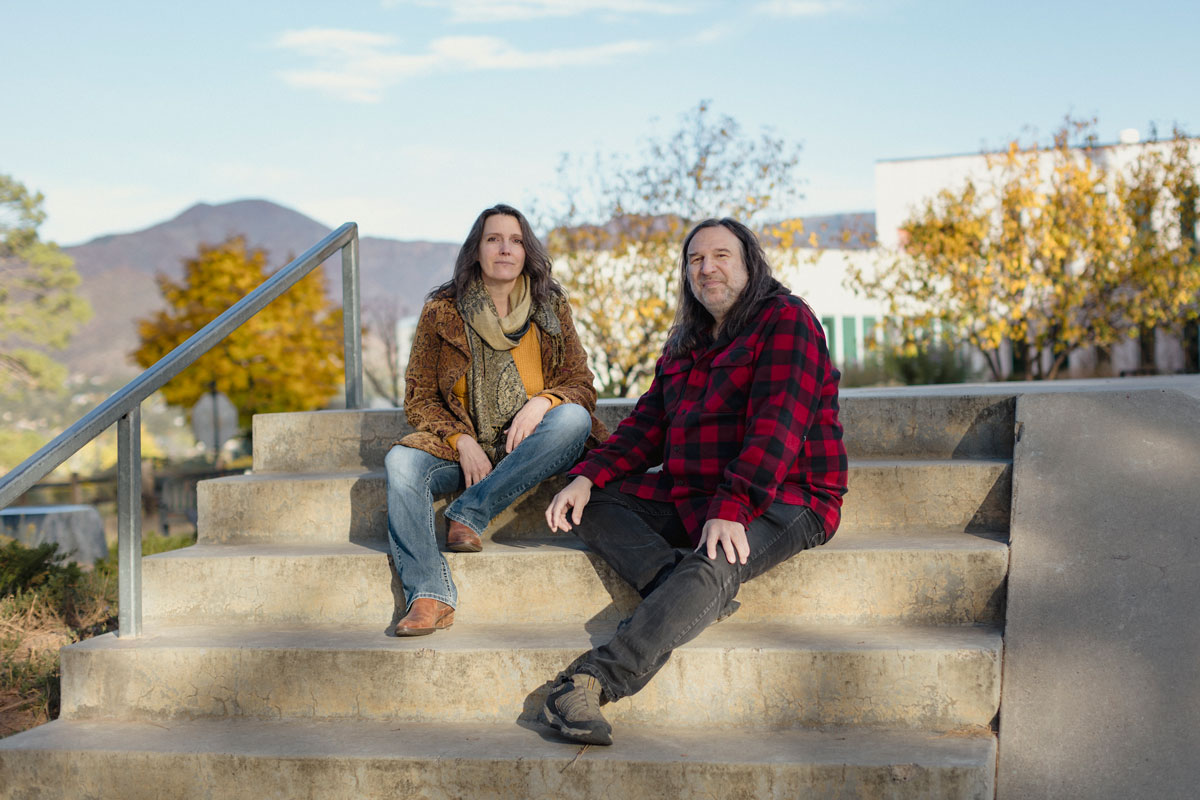Reed Legends at Los Alamos
Mark Galassi ’87 and Tess Light ’91 are on the frontlines of nuclear nonproliferation.
Tess Light ’91 has a theory about why so many Reedies feel drawn to the deserts of Los Alamos: Despite being over a thousand miles apart, Reed and the birthplace of the atomic bomb share a similarly “quirky and cerebral” sensibility. “It’s definitely not normal, but it’s great,” Tess says. “Nobody’s going to shy away from a challenging conversation.”
Tess certainly hasn’t. For two decades, she has been a leading scientist in Los Alamos National Laboratory’s Space-Based Nuclear Detonation Detection Program—and in 2021, she was awarded the Los Alamos Global Security Medal, solidifying her place in the field of nuclear nonproliferation.
Mark Galassi ’87, a physicist and computer scientist who has worked in Los Alamos for many years, can relate. In addition to pioneering nonproliferation efforts of his own, he founded the Institute for Computing in Research to mentor summer research students, many of whom come to work at Los Alamos.
The pursuit of tangible good through tireless research brought both Mark and Tess to Los Alamos. This is how their journeys took shape.
Mark Galassi
Mark Galassi’s work is “cosmically important”—just ask Mark Galassi. “I have the opposite of imposter syndrome,” Mark admits, exuding a well-earned confidence. In addition to being a renowned physicist and computer scientist, he was one of the inaugural winners of the Los Alamos Community Relations Medal, which he received for founding the Institute for Computing in Research, which has mentored hundreds of students.
Manhattan-born Mark was raised in France and Italy, but his father was determined that he attend college in the United States. Then, in the 1982 Selective Guide to Colleges, Mark read a sentence that would lure him to Reed and forever shape his career. “It had this line that read something like, ‘All of them are smart, many are geniuses, and most of them want to change the world,’” Mark recalls. He was hooked.
After completing his thesis, “Lagrangian Field Theory of Anisotropic Systems,” written under Prof. Nicholas Wheeler ’55 [physics 1963–2010], and finishing his PhD at Stony Brook University, Mark moved to Santa Fe, New Mexico, to work at Los Alamos National Laboratory in the Theoretical Astrophysics group. But he soon shifted to the Space Science and Applications group, where he would remain for most of his career.
Mark has lent his expertise to everything from the HETE (High Energy Transient Explorer) and HETE-2 satellites to the Space-Based Nuclear Detonation Detection Program, on which he collaborated with Tess. Yet he is just as esteemed as a mentor as he is as a research scientist, having founded the Institute for Computing in Research. According to Mark, his students are already challenging the dedication of even senior scientists at Los Alamos. “I bring in a cohort of 10 or 11 students—more than half of them Reed students—and they just crank out solid results all day long,” he says.
When it comes to the subject of his scientific legacy, Mark can be self-deprecating—he’s leery of the “cult of personality” effect associated with his career—but he’s also bullish on the long-term significance of his achievements.
“I think nuclear nonproliferation is extremely important,” he says. “I do like to tell people that when you’re a physicist, you can combine pure research, pure fundamental science, with something that is in the world’s interest.”
Sounds like a matter of cosmic importance.
Tess Light
In Tess Light’s play To Conceive Gods, a scientist named Helen Pario seeks to create the first artificial cell, an achievement that would make her a living deity. It’s an occupation that mirrors Tess’s work as a senior scientist in Los Alamos National Laboratory’s Intelligence and Space Research division. “I’m the world’s most unsuccessful playwright,” Tess deadpans, despite having won the 2017 Julie Harris Playwriting Award and being the 2015 winner of the Arts & Letters Prize for Drama. “I don’t think we need to make too much of that.”
What Tess is unequivocally successful at is her work at Los Alamos National Laboratory, where she is a Laboratory Fellow working in the United States Nuclear Detonation Detection System (USNDS) program. “I’m a very practical person,” says Tess, whose current projects include designing software for next-generation sensors. “My story about why I came here to work on these very practical problems, that jazzes me—doing something that’s immediately tangible and useful.”
Tess’s thesis, written under Prof. Robert Reynolds [physics 1963–2002, 2006–08], was titled “Reflectance Models of Pluto: Mapping the Surface of the Ninth Planet” (Pluto would not be demoted to dwarf planet until 2006). Despite yearning for scientific pursuits more applied than astrophysics, Tess was baffled when a friend suggested Los Alamos National Laboratory.
“I said, ‘What, are you crazy?’” she recalls. “That’s not making the world a better place. I don’t want to make bombs. And he laughed at me and said, ‘We do a lot more than that.’” Tess applied to two different groups at Los Alamos, one in Earth and Environmental Sciences and one in the Treaty Monitoring Program, ultimately settling on the latter. Today she represents the electromagnetic pulse sensor development program as its project scientist among the stakeholders of the USNDS, a multiagency program dedicated to detecting nuclear detonations on Earth and in space alike.
“When I go home at Thanksgiving, I can say to my mom, ‘Hey, I work on this thing that matters to you,’” Tess says. “That’s what drew me here. I really believe in it.”
Tags: Alumni, Climate, Sustainability, Environmental, Research
